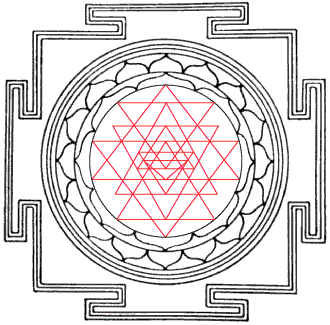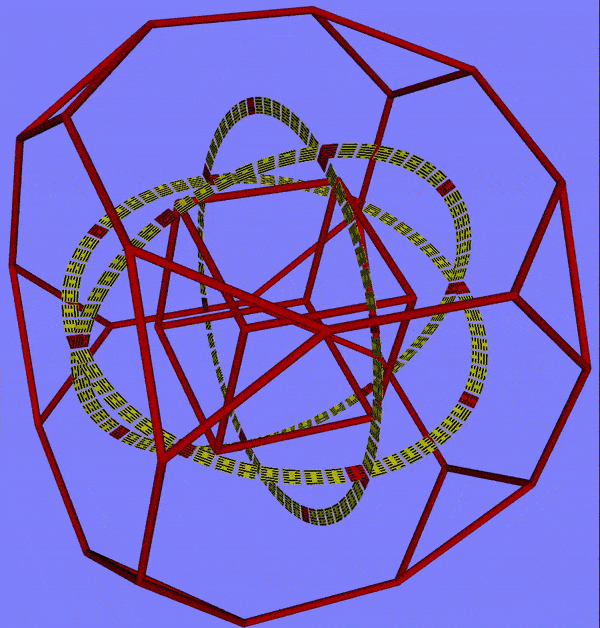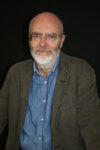Eliciting Insight from Mandala-Style Logos in 3D
TRANSCEND MEMBERS, 18 May 2020
Anthony Judge | Laetus in Praesens – TRANSCEND Media Service
Interactive Engagement with Mandalas and Yantras in Virtual Reality
Commentary on 3D models
This exploration follows from interaction with the Scientific and Medical Network, which uses a mandala-style logo to indicate its focus on exploration of new paradigms with an emphasis on consciousness. The question raised here is whether mandalas imply insight which could be elicited to a greater degree through animation, representation in 3D, and the possibility of user interaction.
It is not however a matter of seeking to exhaust the significance which may be inferred from such configurations, rather it is a question of whether advances in visualization technology, and dissemination of imagery over the web, can enable new possibilities for many. Of particular relevance is the tendency to use centro-symmetrical logos in the style of yantras and mandalas to such more fundamental comprehension of integration..
As an illustrative introduction to development of the argument with respect to interactive animations in virtual reality, a simple possibility of animation of the logo of the Scientific and Medical Network is shown below. What do the design constraints and possibilities then suggest?
| Adaptations of the logo of the Scientific and Medical Network | ||
| Jerky rotation | Static original | Smoother rotation |
 |
 |
 |
Positive versus Negative? A further issue is the valuable challenge to any assumption that such logos are a focus or container for the “positive” and desirable only — thereby designing out the “negative” and undesirable. Arguably the more fundamental challenge is to find ways of using the implied cogitive dynamics of such configurations so as to contain both positive and negative in a more fruitfully integrative manner.
A valuable metaaphor in that respect is the design of electrical circuits. These require two wires in order to carry positive and negative currents, whether directly or by alternation. Stripping out one wire to eliminate the negative is neither feasible nor desirable. The argument has been developed otherwise by Barbara Ehrenreich (Bright-sided: how the relentless promotion of positive thinking has undermined America; Smile Or Die: how positive thinking fooled America and the World, 2009). The argument clearly has implications for the emerging trend towards suppressing all communications on the internet which use any form of negative expression.
Psychosocial motors and dynamos? The argument with respect to postive-negative is inspired by the remarkable innovations of Nikola Tesla at the beginning of the last century regarding the rotation of magnetic fields enabling dynamos and electrical motors (Reimagining Tesla’s Creativity through Technomimicry: psychosocial empowerment by imagining charged conditions otherwise, 2014). An analogue was specifically discussed and illustrated in the latter, as reproduced below (Potential implications of alternation and rotation in psychosocial fields, 2014).
The animation on the right is an adaptation of the Sri Yantra of the Shri Vidya school of Hindu tantra. The central part is formed of nine interlocking triangles that surround and radiate out from the central point. As being suggestive of cognitive “wiring”, the set of triangles is rotated through three positions at the same rate as that of the animation on the left.
| Potential correspondences between electrical and cognitive cycles? | |
| Magnetic field and vectors from 3-phase coils (animation reproduced from Wikipedia) |
Experimental 3-phase animation of classic Sri Yantra (core “wiring” configuration passes through 3 phases) |
 |
 |
As a further experiment, the set of triangles is rotated at the same rate through 8-phases (image on left below) and 16-phases (image on right). Clearly further experiments of mnemonic significance could be undertaken by rotating different triangles at different rates, possibly differently coloured.
| Experimental animations passing through more phases | |
| Animation through 8 phases | Animation through 16 phases |
 |
 |
The argument can be developed further with other imagery (Representation of Creative Processes through Dynamics in Three Dimensions, 2014). The animations above raise the question of how they might be represented in 3D and what further insight they might then enable. The point is developed further through experimentation with the display of the “1,000 petalled” crown chakra below — with 20 rings of 50 petals.
| Adaptations inspired by the logo of the Scientific and Medical Network (variously suggestive of positively-negatively charged dynamics) |
||
| Alternation of charges | Static original | Rotation of whole |
 |
 |
 |
| Many variations of colour, rotation and rate can be explored | ||
Interactive displays in virtual reality: The technical problem with respect to interactive web dissemination has been the constraint (notably for the author) of enabling representation in virtual reality rather than simply presenting videos or animated gifs. This is despite being able to generate such interactive 3D models locally with other software protocols (X3D, VRML).
Such interactivity can however be offered over the web in some cases by embedding such displays using X3DOM technology. Access to a number of dynamic centro-symmetric displays is offered below. Some derive from the design metaphors and themes illustrated in 2D animations/projections in the imagery below.
Some may not work, depending on the speed of the internet connection, especially for the more complex. Conventional video alternatives are indicated for convenience in the event of difficulty, although that option is not the purpose of this presentation.
- Crown chakra or Sahasrara: namely the so-called “1,000 petalled lotus“, for which a variety of dynamic 3D models are presented and discussed in Crown chakra as circular configuration of rotating heart-patterns; Construction of crown chakra in 3D using a twisted torus; Crown chakra embodying gimbal dynamics to frame the Axis Mundi (2020). Arguably this is an expreme variant of the mandala-yantra metaphor. That shown below has the configuration of concentric rings rotating in the plane of the page.
- Interactive 3D demos:
- Independent rotation of total set of 20 rings of 50 petals – flat clockwise rotation
- Independent rotation of total set of 20 rings of 50 petals – flat anticlockwise rotation
- Independent rotation of total set of 20 rings of 50 petals – flat alternate ring rotation
- videos: clockwise; anti-clock; alternate (long); vertical rotation (into screen, as indicated below) — X3D
- Stack of set of 20 moving rings of 50 petals (videos: shorter; longer) — X3D
- Stack of set of 20 moving rings of 50 petals — with Vajra symbols — X3D
- Gyroscopic movement of selected rings of 50 petals – outline (video) — X3D
- Interactive 3D demos:
- Circle of 64 hexagrams of Shao Yong: For which a variety of configurations are presented and discussed in Toroidal constraint — nuclear fusion as metaphor of cognitive fusion (2019). That shown below is a configuration of 3 mutually orthogonal rings of hexagrams each rotating within a drilled truncated cube — a toroidal polyhedron with 64 edges.
- Symbols of Abrahamic religions: As an exercise in projective geometry, a mutuaally orothogonal rendering can be explored (Reconciling Symbols of Islam, Judaism and Christianity, 2017). With respect to the Star of David, various dynamics of “cognitive cycles” can be speculatively rendered in a 3D development as the Merkabah (Cognitive implication in Merkabah as configuration of cycles essential to systemic viability, 2017)
- Interactive 3D demos:
- Ten Oxherding Images of Zen in a Torus — Variant with bulls moving
| Animations indicative of interactive possibilities in virtual reality (enlarged versions of the animations can be viewed with standard browser facilities) |
|||
| Crown chakra rings | Triple circle of hexagrams | Triple Mandelbrot rendering | Merkaba — spheres/rings |
 |
 |
 |
 |
Other examples of potential interest include:
- Concordian Mandala: Dynamics of Toroidal Helical Coils: Exploration in virtual reality of the requisite complexity in a mandala (Visualization in 3D of Dynamics of Toroidal Helical Coils in quest of optimum designs for a Concordian Mandala, 2016)
- Interactive demo:
- Mandelbrot set rendering on the complex plane: The complexity sciences attach significance to the complex plane on which the Mandelbrot set is typically rendered. Speculatively three such images may be displayed in a mutually orthogonal configuration as shown below, and discussed separately (Mandelbrot sets rendered in a mutually orthogonal configuration of 3 complex planes, 2019)
- Interactive 3D demos (working, but with a colouring issue in X3DOM):
- Ring of 6 Szilassi polyhedra
- comments: Dynamics
- of discord anticipating the dynamics of concord (2018)
- Pumping cycle of 5 nested Platonic polyhedra
- comments: Relative movement of nested Platonic polyhedra: pumping and rotation (2015)
- Dynamics of cube edges
- comments: Psychosocial Implication in Polyhedral Animations in 3D ( 2017)
- Dynamics of movement of parallel edges of drilled truncated cube (video; X3D)
- comments: Psychosocial Implication in Polyhedral Animations in 3D (2017)
__________________________________________
 Anthony Judge is a member of the TRANSCEND Network for Peace Development Environment and mainly known for his career at the Union of International Associations (UIA), where he has been Director of Communications and Research, as well as Assistant Secretary-General. He was responsible at the UIA for the development of interlinked databases and for publications based on those databases, mainly the Encyclopedia of World Problems and Human Potential, the Yearbook of International Organizations, and the International Congress Calendar. Judge has also personally authored a collection of over 1,600 documents of relevance to governance and strategy-making. All these papers are freely available on his personal website Laetus in Praesens. Now retired from the UIA, he is continuing his research within the context of an initiative called Union of Imaginable Associations. Judge is an Australian born in Egypt, a thinker, an author, and lives in Brussels. His TMS articles may be accessed HERE. (Wikipedia)
Anthony Judge is a member of the TRANSCEND Network for Peace Development Environment and mainly known for his career at the Union of International Associations (UIA), where he has been Director of Communications and Research, as well as Assistant Secretary-General. He was responsible at the UIA for the development of interlinked databases and for publications based on those databases, mainly the Encyclopedia of World Problems and Human Potential, the Yearbook of International Organizations, and the International Congress Calendar. Judge has also personally authored a collection of over 1,600 documents of relevance to governance and strategy-making. All these papers are freely available on his personal website Laetus in Praesens. Now retired from the UIA, he is continuing his research within the context of an initiative called Union of Imaginable Associations. Judge is an Australian born in Egypt, a thinker, an author, and lives in Brussels. His TMS articles may be accessed HERE. (Wikipedia)
This work is licensed under a Creative Commons Attribution-NonCommercial 4.0 International License.
Go to Original – laetusinpraesens.org
DISCLAIMER: The statements, views and opinions expressed in pieces republished here are solely those of the authors and do not necessarily represent those of TMS. In accordance with title 17 U.S.C. section 107, this material is distributed without profit to those who have expressed a prior interest in receiving the included information for research and educational purposes. TMS has no affiliation whatsoever with the originator of this article nor is TMS endorsed or sponsored by the originator. “GO TO ORIGINAL” links are provided as a convenience to our readers and allow for verification of authenticity. However, as originating pages are often updated by their originating host sites, the versions posted may not match the versions our readers view when clicking the “GO TO ORIGINAL” links. This site contains copyrighted material the use of which has not always been specifically authorized by the copyright owner. We are making such material available in our efforts to advance understanding of environmental, political, human rights, economic, democracy, scientific, and social justice issues, etc. We believe this constitutes a ‘fair use’ of any such copyrighted material as provided for in section 107 of the US Copyright Law. In accordance with Title 17 U.S.C. Section 107, the material on this site is distributed without profit to those who have expressed a prior interest in receiving the included information for research and educational purposes. For more information go to: http://www.law.cornell.edu/uscode/17/107.shtml. If you wish to use copyrighted material from this site for purposes of your own that go beyond ‘fair use’, you must obtain permission from the copyright owner.